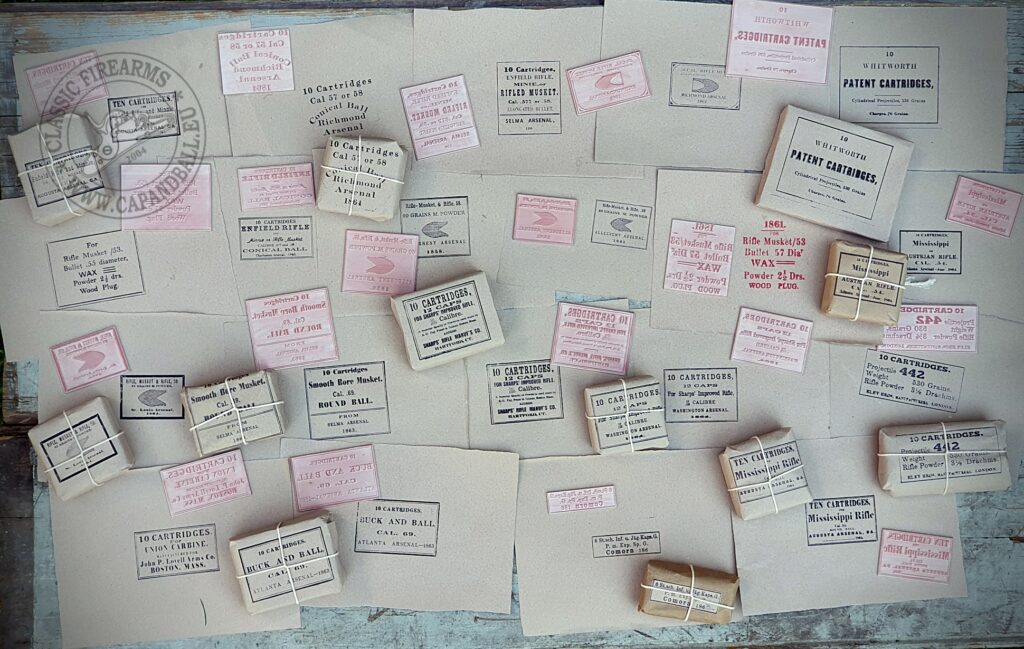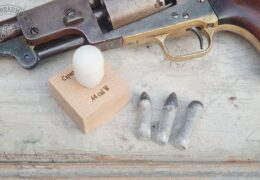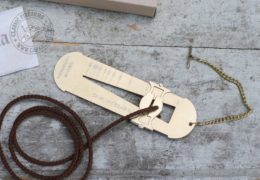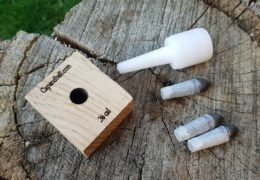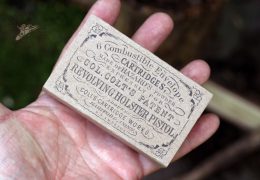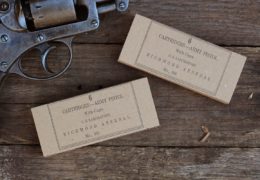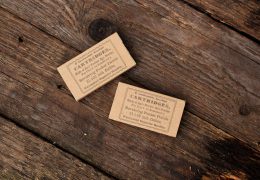Cartridge bundles of the American Civil War
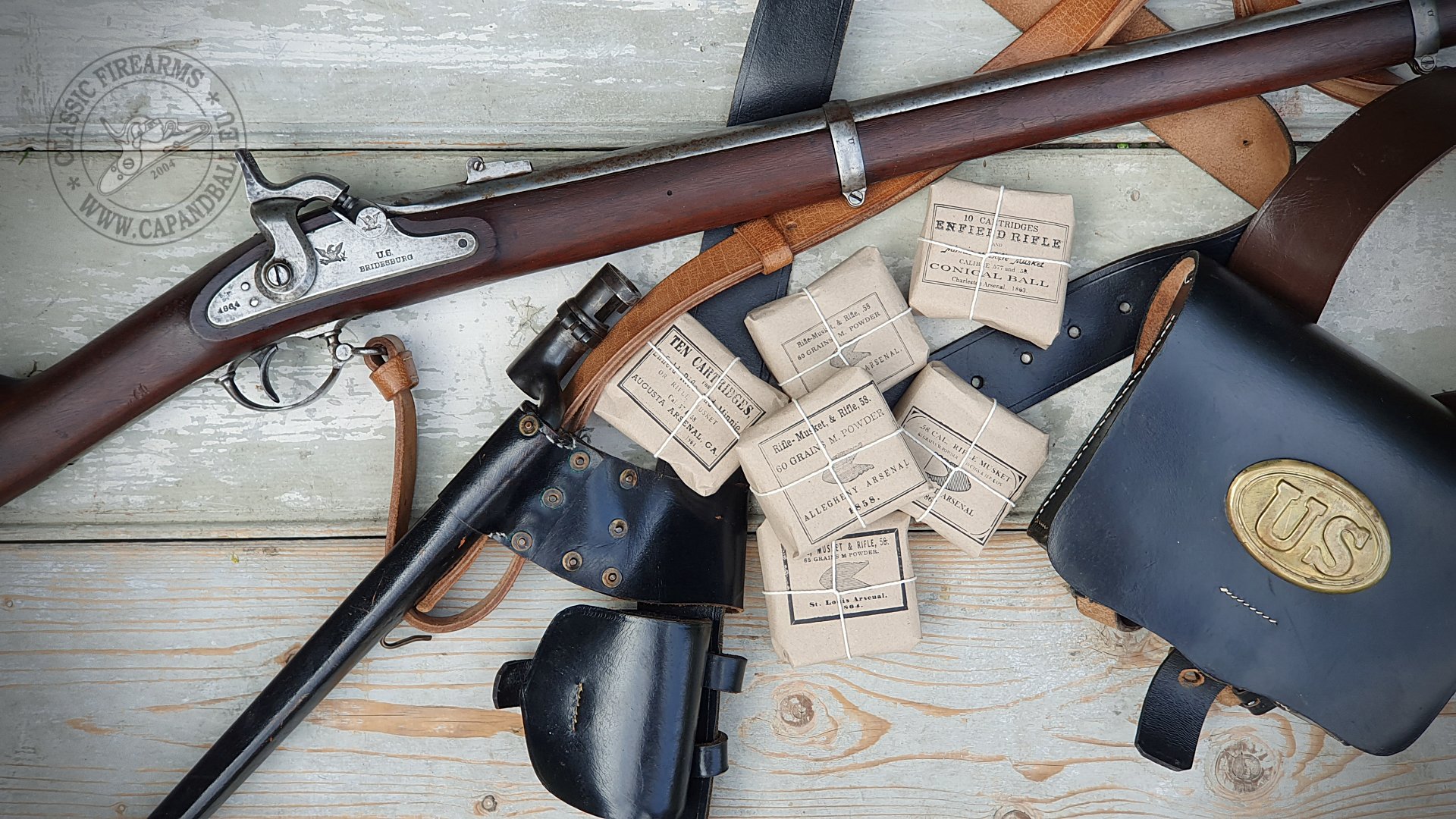
Johnny Reb and Billy Yank filled their cartridge boxes from bundles holding 10 cartridges and the percussion caps. The cartridges were wrapped in paper sheets, and labels were printed or glued to them to indicate the content. These labels always fascinated me as they are just excellent mementos of a long-gone period. The first idea I had was to produce a stamp from my Lorenz rifle exactly following the original arsenal design, so I slowly tooled up to make this stuff. And in the meantime, I started to replicate the wrapper labels of the American Civil war as well. Let’s see now the story of the wrappers.
We are reproducing the printing plates for making your own arsenal label wrappers. Click here to check our offerings!
Cartridge bundles did exist before the Civil War broke out. According to the book, Military Pyrotechny for the Use of Cadets of United States Military Academy, West Point, from 1832, 10 cartridges in two tiers, with alternating balls was bundled in a folding box using a properly sized wrapping paper. According to the Ordnance Manual of 1849, the wrapping paper war waterproofed by immersing it into the molten mix of beeswax, linseed oil and spirits of turpentine. These wrappers did not have any imprint or sticker on them.
With the introduction of the Model 1855 rifle musket and its cartridge loaded with a 500 grain Minié-Burton ball and 60 grains of musket powder, more detailed information was provided on properly bundling cartridges. The printing plates for the first labels of cartridge bundles were designed and made by the Frankford Arsenal in 1857. These stamps were prepared only for the Arsenals of Construction, namely Allegheny, Watervliet, St. Louis, Washington and Benicia. The five presses with five plates were completed in 1857, but the earliest known cartridge label from the Allegheny Arsenal is dated 1858.
These labels provided information about the weapon, its calibre, powder charge, type of bullet, place and date of manufacture.
The Ordnance Manual of 1861 added important details to the construction of cartridge bundles. The most important tool in bundling the cartridges was the bundling box without ends. The distance between the sides was 5 times the diameter of the ball, while the height of the sides was two times the ball size, meaning each long gun calibre required its own calibre specific bundling tool.
The wrapping paper size also differed from calibre to calibre:
| Wrapper size | Bundle size | ||||
| Length (inch) | Width (inch) | Length (inch) | Width (inch) | Depth (inch) | |
| .69 Musket Minié | 10 | 8 | 2,5 | 3,4 | 1,45 |
| . 58 Musket and rifle Minié | 9 | 6,5 | 2,6 | 2,9 | 1,15 |
| .69 Round ball | 9 | 6,5 | 2,6 | 3,1 | 1,35 |
| .69 Buck n’ ball | … (likely same as RB) | … (likely same as RB) | 3,1 | 3,1 | 1,35 |
| .54 Sharps | 10 | 6,8 | 2,6 | 2,5 | 1,1 |
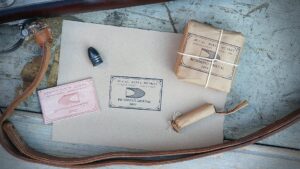 These paper sheets were waterproofed with the same mix as mentioned in the previous ordnance manual, and had to be large enough to accept the 11th cartridge of the bundle, the pack of 12 percussion caps rolled into a paper tube. According to the Ordnance Manual of 1861, the bundling was done the following way:
These paper sheets were waterproofed with the same mix as mentioned in the previous ordnance manual, and had to be large enough to accept the 11th cartridge of the bundle, the pack of 12 percussion caps rolled into a paper tube. According to the Ordnance Manual of 1861, the bundling was done the following way:
“Put a wrapper in the box, the long side perpendicular to the edge of the table, the middle of the paper in the middle of the box; place, parallel to the sides of the box, two tiers of cartridge of 5 each, the balls alternating; bring the short ends of the paper together, and fold them twice close down on the cartridges; insert a package of caps in the end of the bundle next to the ends of the lower tier; fold the wrapper on the ends and tie the bundle, first in the direction of the length, then its breadth, with the twine fastened in a single bow-knot. The wrappers are of different colours, to distinguish the cartridges for the different arms.”
The colour codes were not really used. Theoretically the expanding ball .69 cal musket and .58 cal rifle and rifle musket cartridges had ordinary colour wrappers, the .58 cal cadet rifle shooting a lighter recoil cartridge with decreased powder charge and bullet wait had red colour wrapper, the .69 cal ball cartridges wrappers were supposed to be of green colour, while the buckshot cartridge wrappers were supposed to be red again. In practice these colour codes were seldom used during the conflict, therefore the labels and images of the wrappers were the key information source in differentiating the various cartridge bundles.
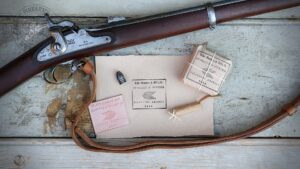 As the Civil War broke out large number of the cartridge manufacturers were involved into ammunition production, that multiplied the number of graphics on wrappers. Nearly all Arsenals and private contractors designed their own graphics. The more industrialized North tooled up for the production of the standard cartridge holding a .5775” 500 grain Minié ball and 60 grains of musket powders. But the situation of the Confederacy was much more delicate.
As the Civil War broke out large number of the cartridge manufacturers were involved into ammunition production, that multiplied the number of graphics on wrappers. Nearly all Arsenals and private contractors designed their own graphics. The more industrialized North tooled up for the production of the standard cartridge holding a .5775” 500 grain Minié ball and 60 grains of musket powders. But the situation of the Confederacy was much more delicate.
And the Civil War broke out…
By the time the hostilities broke out between north and south, out of the 7 arsenals producing small arms ammunition, only one, Baton Rouge was located on southern soil. At the initial phase of the conflict the Confederacy had not more than a million rounds of small arms ammunition on stock. Chief of Ordnance Josiah Gorgas, and Superintendent of the Laboratories John Mallet played a vital part in building the CS ammo supply from nearly nothing. Ammo supply was based on domestic manufacturing and import. The first created a huge variety of cast and machine pressed bullets with dimensions and powder loads varying greatly. The second source offered more uniform cartridges but was less reliable, as the import from European countries, mainly Great Britain, had to break through the naval blockade of the Union.
The situation was really confusing: the weight and size of the balls cast at different location varied a lot, there were two type of cartridges in service: the American style with a grease groove bullet intended to be loaded naked, and the British style cartridges intended to be loaded with paper patching.
These British import cartridges were also manufactured two different diameter bullets: the .57 and .55 Pritchett balls. Finally, the C. S. Army settled for the British construction method, but with a projectile of .562” diameter and a powder load of 75 grains of musket powder. This could be a really confusing situation, a reason why manufacturers like Eley Brothers added a small note to each cartridge bundles telling the proper way to load the cartridges.
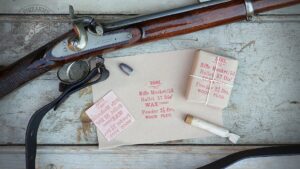 The confederacy had a will to standardize its ammo supply to simplify logistics. The .577 cal Enfield and .58 cal American rifle muskets needed a projectile that fits both. Another confusing factor was the construction of the cartridges. While the Minié balls of the American rifle musket cartridges were intended to be loaded naked, without the paper wrapping, the British made Enfield pattern cartridges were loaded with an undersized Pritchett ball, intended to be loaded with the paper patching.
The confederacy had a will to standardize its ammo supply to simplify logistics. The .577 cal Enfield and .58 cal American rifle muskets needed a projectile that fits both. Another confusing factor was the construction of the cartridges. While the Minié balls of the American rifle musket cartridges were intended to be loaded naked, without the paper wrapping, the British made Enfield pattern cartridges were loaded with an undersized Pritchett ball, intended to be loaded with the paper patching.
To ease the confusion the Confederacy finally accepted the British cartridge pattern, with a projectile diameter of 0.562”, a calibre that can fit both English and American bores. The powder charge was also increased to 75 grains of musket powder. Even if the decision was made, the situation did not change, as the CS army often used ammo from war booty seized from US troops.
A reason why manufacturers like Eley Brothers added a small note to each cartridge bundles telling the proper way to load the cartridges. The confusion was also fed by the official documents of the CS army. Small arms making was described in the Ordnance Manual, Field Manual for the Use of the Officers of Ordnance Duty, and in the Rules to be Observed in the laboratories of C. S. Arsenals and Ordnance Depots. Interestingly the Ordnance manual still described the standard American cartridge with 0.5775” bullet with 60 grains of musket powder, while the other two documents already described the new, British style cartridges.
Why the Enfield pattern?
Choosing the Enfield pattern cartridges for the C.S. Army had its advantages and drawbacks as well. Although the Pritchett bullet was easier to manufacture, its accuracy highly depended on the quality of the paper patching. The C.S. army had its own paper mills, but their output was anywhere near the demand from the ammo making facilities. The imported Enfield cartridges had their problems as well. They were too long for the standard cartridge boxes, so large numbers had to be repacked with reduced length, or the tins in the cartridge boxes had to be modified.
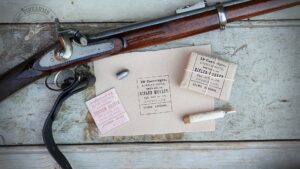 The cartridge bundles also differed in the Confederacy. First of all, it was recommended to mark them with the month of the fabrication as well. Second, the number of caps in the paper tube would be 13 instead of 12 in the late years of the war. In many cases the supply of caps was critically short. If the caps were missing from the bundle, the wrapper would be marked as “without caps”. The design of wrappers closely followed the rules described in the 1861 Ordnance Manual, but in many cases the graphics were printed of stickers instead on the wrapper itself.
The cartridge bundles also differed in the Confederacy. First of all, it was recommended to mark them with the month of the fabrication as well. Second, the number of caps in the paper tube would be 13 instead of 12 in the late years of the war. In many cases the supply of caps was critically short. If the caps were missing from the bundle, the wrapper would be marked as “without caps”. The design of wrappers closely followed the rules described in the 1861 Ordnance Manual, but in many cases the graphics were printed of stickers instead on the wrapper itself.
Printing of these labels were done using complete plates, not using the movable type method shown in my video, meaning the letters and lines were not assembled in the letter case, but the complete graphic was cut on a plate. Guttenberg did not invent the printing press or movable type, nor he did invent printing itself, but he was the first one to use type cast from lead, and he did invent the oil-based printing ink. The Latin alphabet was simple enough so these inventions could increase the productivity of printing. The simple Guttenberg presses were widely used all across the World in the beginning of the 19th century, but by these times, another revolution was starting in printing: automation, the use of steam power and replacing the printing flatbed with rotary motion cylinders.
So, this is how these wrappers were born, and how they were used. I had this project in mind for a long time to replicate these as I really love the periodical look of these old labels and they add a lot to the feel when you make cartridges and bundles for your original firearm. So, I spent the last weeks redrawing them one by one in vector graphics as closely replicating the originals as possible. we have now nearly 25 types of rubber stamps for CS and US arsenal labels available in our web shop. They will serve you well in printing thousands of wrapper labels or stickers for your favorite historical firearms. We will keep working in new types as well, so follow us to see how we expand our stamp portfolio.
Capandball Arsenal rubber printing plates
These rubber printing plates (stamps) are faithful reproductions of the stamping plates used during the American Civil War to mark the arsenal bundles of 10 ten cartridges. Each label provided information on the firearm, its calibre, the powder charge of the cartridge, the type of bullet, the maker and the date of production. These images are redrawn with the highest possible detail to provide sharps and crisp images for making the plates. Using our printing plates for making fully authentic cartridge wrappers is easy as it can be. Printing with plates is the only fully authentic way of applying the graphics to the cartridge bundles.
Please note that you are solely purchasing the rubber plate, no other accessories are shipped in the package, except for this manual of instructions.
Instructions on making bundles
Tools you will need: scissors, white string, off-white craft paper, folding box, .54 cal wooden dowel for making cartridges, ink stamp pad, stamping ink
- Cut the paper sheets.
|
|
Wrapper size | Bundle size | |||
| Length (inch) | Width (inch) | Length (inch) | Width (inch) | Depth (inch) | |
| .69 Musket Minié | 10 | 8 | 2,5 | 3,4 | 1,45 |
| . 58 Musket and rifle Minié | 9 | 6,5 | 2,6 | 2,9 | 1,15 |
| .69 Round ball | 9 | 6,5 | 2,6 | 3,1 | 1,35 |
| .69 Buck n’ ball | 9 | 6,5 | 3,1 | 3,1 | 1,35 |
| .54 Sharps | 10 | 6,8 | 2,6 | 2,5 | 1,1 |
Theoretically the expanding ball .69 cal musket and .58 cal rifle and rifle musket cartridges had ordinary colour wrappers, the .58 cal cadet rifle shooting a lighter recoil cartridge with decreased powder charge and bullet wait had red colour wrapper, the .69 cal ball cartridges wrappers were supposed to be of green colour, while the buckshot cartridge wrappers were supposed to be red again. In practice these colour codes were seldom used during the conflict, therefore the labels and images of the wrappers were the key information source in differentiating the various cartridge bundles.
- Make the folding box by nailing two strips of wood to a 10×8” wooden plank. The length of the wooden strip is 2.6”, the distance between them is 5 times the diameter of the ball, their height is two times the diameter of the ball
- Attach the rubber stamp to an appropriate size of wood with surface sanded smooth. Use double sided tape to attach the stamp.
- Apply ink to the stamp using the ink pad saturated with the desired colour (black or red) ink. Be sure that the complete surface is covered. Place the paper sheet on a semi hard surface (like 10 sheets of paper), and gently press the stamp on the paper. Experiment with different inks, pressure and paper quality to get the best result.
- Place the wrapper paper in the centre of the folding box, with the short sides towards the two sides of the box.
- Please 10 cartridges parallel with the sides of the box on the wrapper in two tiers with balls alternating.
- Roll a cartridge trapezoid on the .54 cal wooden former, choke and tie on one end, add 12 or 13 (late C.S.) percussion caps, and fold the tail. Insert the cap’s package in the opening of the cartridge bundle.
- Bring the two short sides of the paper together, and fold the sides like you were wrapping a gift box. Do not make perfect edges, but the bundle has to be stiff.
- Tie the bundle, first in the direction of the length, then its breadth, with the twine fastened in a single bow-knot.
- Enjoy your excellent cartridge bundle creating according to the original method using a Capandball Arsenal label stamp.
Balázs Németh, 2020. August

